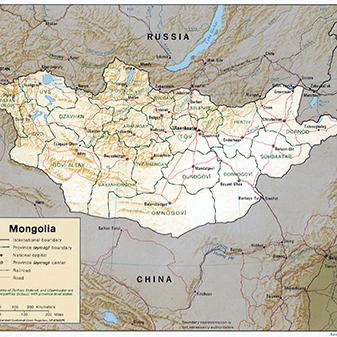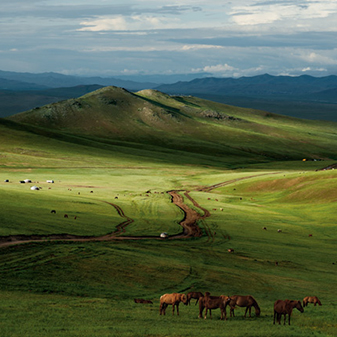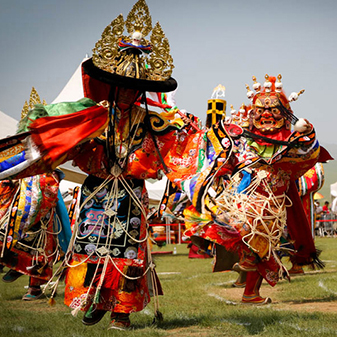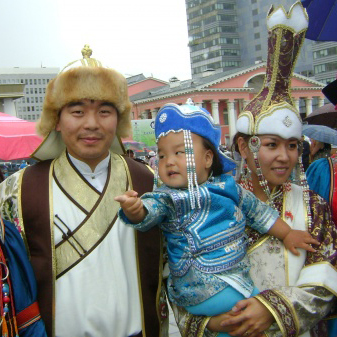NATIONAL HOLIDAYS
National Naadam Festival: July 11-13
New Year’s Day: January 1
Tsagaan Sar (Lunar New Year): According to Lunar Calendar, which marks the end of winter and the beginning of spring
Mother & Children’s Day: June 1
Independence Day: December 29
International Women’s Day: March 8
Genghis Khan’s birthday First day of the first winter month of the year: November 14

NATIONAL HOLIDAYS
National Naadam Festival: July 11-13
New Year’s Day: January 1
Tsagaan Sar (Lunar New Year): According to Lunar Calendar, which marks the end of winter and the beginning of spring
Mother & Children’s Day: June 1
Independence Day: December 29
International Women’s Day: March 8
Genghis Khan’s birthday First day of the first winter month of the year: November 14

NAADAM FESTIVAL
The biggest event of the year in Mongolia is the Naadam Festival, known as the Eriin Gurvan Naadam, after the three ‘manly sports’ of wrestling, archery and horse racing. It was celebrated for centuries as a test of courage and strength of nomadic people and warriors. People coming from all corners of the country and abroad enjoy watching the Naadam Games. The Naadam Festival is held every summer between 11-13 July at the Central Stadium in Ulaanbaatar, it is a traditional display of Mongolian courage, strength, dexterity and marksmanship.

Wrestling
Mongolian wrestling is similar to wrestling found elsewhere, except there are no weight divisions, so the biggest wrestlers are often the best. Mongolian wrestling also has no time limit- the bout will continue with short breaks. It will end only when the first wrestler falls, or when anything other than the soles of the feet or open palms touch the ground.
NAADAM FESTIVAL
The biggest event of the year in Mongolia is the Naadam Festival, known as the Eriin Gurvan Naadam, after the three ‘manly sports’ of wrestling, archery and horse racing. It was celebrated for centuries as a test of courage and strength of nomadic people and warriors. People coming from all corners of the country and abroad enjoy watching the Naadam Games. The Naadam Festival is held every summer between 11-13 July at the Central Stadium in Ulaanbaatar, it is a traditional display of Mongolian courage, strength, dexterity and marksmanship.
Wrestling
Mongolian wrestling is similar to wrestling found elsewhere, except there are no weight divisions, so the biggest wrestlers are often the best. Mongolian wrestling also has no time limit- the bout will continue with short breaks. It will end only when the first wrestler falls, or when anything other than the soles of the feet or open palms touch the ground.

Archery
Like horse racing, the sport of archery originates from the warring era, starting from around the 11th century. Archers use a bent composite bow made of layered horn, bark and wood. Usually, arrows are made from willows and the feathers are from vultures and other birds of prey. Traditionally dressed male archers stand 75m from the target, while women archers stand 60m from it. The target is a line of up to 360-round gray, red and/or yellow leather rings (known as sur) on the ground. Usually there are only about 20 or 30 rings.

Archery
Like horse racing, the sport of archery originates from the warring era, starting from around the 11th century. Archers use a bent composite bow made of layered horn, bark and wood. Usually, arrows are made from willows and the feathers are from vultures and other birds of prey. Traditionally dressed male archers stand 75m from the target, while women archers stand 60m from it. The target is a line of up to 360-round gray, red and/or yellow leather rings (known as sur) on the ground. Usually there are only about 20 or 30 rings.


Horse Racing
There are normally six categories of horse racing, depending on the age of horses: for example, a two-year-old horse, called a shudlen, will race for 15km, while six and seven-year-old azraga and ikh nas horses race for up to 30km. There are no tracks or courses; it is just open countryside, which leaves great scope for cheating. Jockeys – boys and girls aged between five and 13 years old – prepare for months for special races, particularly at Naadam. Before a race, the audience, all decked out in traditional finery, often sings traditional songs. The young riders sing a traditional anthem called a gingo before the race, and scream ‘goog’ at the horses during the race.
Horse Racing
There are normally six categories of horse racing, depending on the age of horses: for example, a two-year-old horse, called a shudlen, will race for 15km, while six and seven-year-old azraga and ikh nas horses race for up to 30km. There are no tracks or courses; it is just open countryside, which leaves great scope for cheating. Jockeys – boys and girls aged between five and 13 years old – prepare for months for special races, particularly at Naadam. Before a race, the audience, all decked out in traditional finery, often sings traditional songs. The young riders sing a traditional anthem called a gingo before the race, and scream ‘goog’ at the horses during the race.

LUNAR NEW YEAR
Mongols have been celebrating the New Year according to the lunar calendar for more than 2000 years. Each year of the 12-year cycle of the Lunar Calendar is named after one of twelve animals: Rat, Ox, Tiger, Rabbit, Dragon, Snake, Horse, Sheep, Monkey, Cock, Dog and Pig.
Today, the Lunar New Year remains the holiday Mongols most look forward to, celebrated as a greeting of Spring, when nature and people are renewed and inspired to take on new challenges and endeavors. We will spend this celebration with a nomadic family and experience the holiday first-hand, which consists largely of feasting and togetherness, by sampling traditional Mongolian vodka and steamed dumplings.

LUNAR NEW YEAR
Mongols have been celebrating the New Year according to the lunar calendar for more than 2000 years. Each year of the 12-year cycle of the Lunar Calendar is named after one of twelve animals: Rat, Ox, Tiger, Rabbit, Dragon, Snake, Horse, Sheep, Monkey, Cock, Dog and Pig.
Today, the Lunar New Year remains the holiday Mongols most look forward to, celebrated as a greeting of Spring, when nature and people are renewed and inspired to take on new challenges and endeavors. We will spend this celebration with a nomadic family and experience the holiday first-hand, which consists largely of feasting and togetherness, by sampling traditional Mongolian vodka and steamed dumplings.







